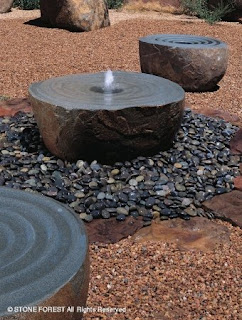Dry riverbeds can be a very ornamental addition to a low water use garden, or they can be horribly ugly! Here are a few things to think about when planning a dry riverbed:
 This first image is an actual dry stream. Instinctively, we know when we are looking at something designed by nature, but what are we actually seeing here? Paying attention to nature can make all the difference between a dry streambed that looks awful and one that increases the curb appeal of your home.
This first image is an actual dry stream. Instinctively, we know when we are looking at something designed by nature, but what are we actually seeing here? Paying attention to nature can make all the difference between a dry streambed that looks awful and one that increases the curb appeal of your home.
1) Streams happen at low spots because that is how water flows. Because of this, your streambed needs to be carved out in a gentle “u” shape. This sounds obvious but is the most overlooked element of a well designed dry riverbed.
2) Water sculpts real streams. In times when the stream is high, it carves away at the streambank, leaving behind larger boulders that are carved into the banks, not placed next to them!
3) As the water flow lessens through the spring, the heavier cobbles fall out of the flow, getting deposited towards the outside of the streambed while the middle of the stream is still flowing. As this continues, the middle of the stream becomes a pattern of smaller cobbles and gravel. A common mistake is only using one size of smaller material for the center of the stream.
Here are a few examples, some better than others:
 This is a pretty high quality artificial streambed. The side boulders are fairly artistically arranged and they have used varying sizes of cobbles in the stream. It has the “u” shape and this allows for the small bridge.
This is a pretty high quality artificial streambed. The side boulders are fairly artistically arranged and they have used varying sizes of cobbles in the stream. It has the “u” shape and this allows for the small bridge.

This one is what the industry referrs to as a necklace because the boulders are strung along the edges without any breaks. Natural streams do not do this. Also, the coble in the center is all large an the same size.

This stream is not bad but a few small changes would have made it significantly more natural: a deeper dug out “u” shape and more rounded boulders. Boulders along a stream have been eroded by the water so they have sinuous soft shapes, not hard edges.

This dry river does a few odd things. It is not dug out at all so it looks like the gravel is scattered on the ground like a pathway. The boulders are quite angular and they have created little dams using ledgestones, which don’t look at all like something a stream would naturally do since ledgestones are very angular and not at all weathered looking. At least it isn’t a necklace, and the accompanying plantings are quite nice.
Sage Outdoor Designs is a San Diego landscape design firm. Kate
Wiseman, the Principal, has been a San Diego landscape designer
for the past ten years. Find out more at www.sageoutdoordesigns.com










